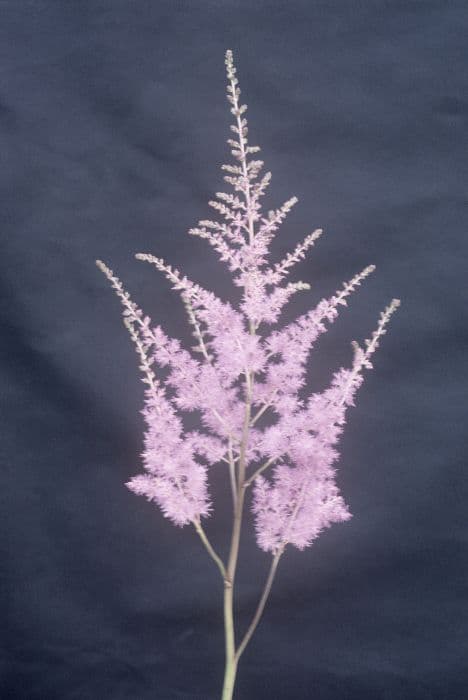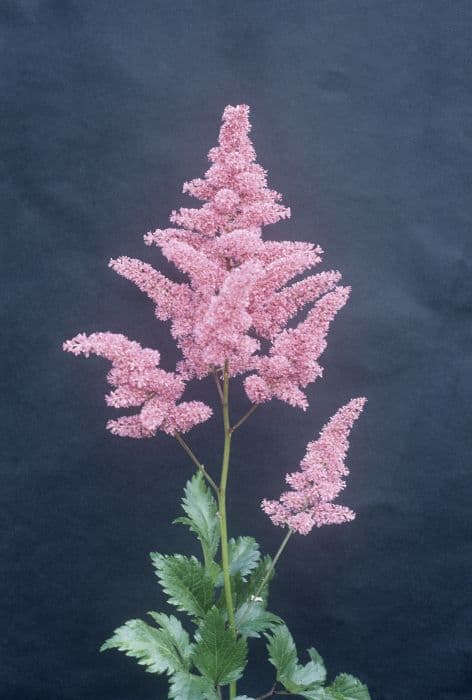Heuchera 'Paris' (PBR)

ABOUT
Heuchera 'Paris' is a stunning perennial commonly known as Coral Bells, noted for its attractive foliage and delicate flower spikes. The leaves of this variety are evergreen, showcasing a year-round display of rounded, lobed leaves with a rich, robust green color. These leaves often have a silvery overlay which enhances their visual appeal, especially when viewed against contrasting plants or backdrops. The most striking feature of Heuchera 'Paris' is its upright stems that bear sprays of small, bell-shaped flowers. These blooms are a vivid shade of pink and appear to float above the foliage like a cloud of color, which can add a touch of romance to any garden setting. The flowers are characterized by their dainty and airy nature, drawing in a plethora of pollinators such as butterflies and hummingbirds. With its lush foliage and vibrant floral display, Heuchera 'Paris' makes for an excellent choice in garden borders, container plantings, or as accent plants. The vibrant color combination and texture provided by this plant have made it a beloved selection for gardeners seeking both visual interest and low maintenance beauty in their outdoor spaces.
About this plant
 Names
NamesFamily
Saxifragaceae
Synonyms
Coral Bells, Alumroot
Common names
Heuchera 'Paris'
 Toxicity
ToxicityTo humans
Coral bells, commonly known as Heuchera 'Paris', are generally considered non-toxic to humans. There are no widespread reports of poisoning from ingesting any part of this plant. Therefore, if consumed, it is not expected to cause harm or significant symptoms of poisoning to humans.
To pets
Coral bells, also known as Heuchera 'Paris', are known to be non-toxic to pets. Ingesting parts of this plant should not result in poisoning or severe health issues for animals such as dogs and cats. Consequently, consuming this plant should not produce toxic symptoms in pets.
 Characteristics
CharacteristicsLife cycle
Perennials
Foliage type
Semi-deciduous
Color of leaves
Mixed
Flower color
Pink
Height
1 foot 1 inch (30 cm)
Spread
1 foot 1 inch (30 cm)
Plant type
Herb
Hardiness zones
4-9
Native area
North America
Benefits
 General Benefits
General Benefits- Attractive Foliage: Heuchera 'Paris' offers year-round foliage with unique coloration, adding visual interest to garden spaces.
- Long Bloom Time: It produces dainty bell-shaped flowers over a long period, often from spring to summer.
- Drought Tolerance: Once established, it is relatively drought-resistant, making it suitable for xeriscaping and water-wise gardens.
- Shade Tolerance: Heuchera 'Paris' can thrive in partial to full shade, offering a beautiful solution for under-canopy and shaded areas.
- Pest Resistance: This plant is typically resistant to deer and rabbits, making it a good choice for gardens troubled by these animals.
- Easy to Grow: It is known to be a low-maintenance plant, requiring minimal care once established, which is ideal for beginner gardeners.
- Low Growing Habit: With its compact size, it serves as an excellent ground cover or border plant, helping to suppress weeds.
- Attracts Pollinators: The flowers of Heuchera 'Paris' are attractive to pollinators such as butterflies and bees, aiding in the health of the garden ecosystem.
- Versatility: It can be used in a variety of garden designs, including rock gardens, container plantings, and as an accent in flower beds.
- Non-Invasive: Heuchera 'Paris' is not known to be aggressive or invasive, ensuring that it won't spread uncontrollably in the garden.
 Medical Properties
Medical PropertiesThis plant is not used for medical purposes.
 Air-purifying Qualities
Air-purifying QualitiesThis plant is not specifically known for air purifying qualities.
 Other Uses
Other Uses- Photography Prop: The distinct foliage and floral characteristics can provide a striking backdrop or subject for macro and nature photographers.
- Learning Tool: Heucheras can be used in educational settings to teach about pollination, as they attract pollinators like bees and butterflies.
- Culinary Decoration: While not widely consumed, the leaves and flowers can be used as an attractive garnish for plates and platters in gourmet presentations.
- Art Inspiration: Artists can draw inspiration from the coral bells' rich colors and varied leaf patterns for paintings, illustrations, and textile designs.
- Fairy Gardens: Due to their compact size and ornamental quality, coral bells are ideal for creating whimsical fairy gardens.
- Natural Dye: The pigments in the leaves and flowers could potentially be used to create natural dyes for fabric or art projects.
- Jewelry Making: Pressed coral bells flowers can be used to make unique items of jewelry such as resin pendants or earrings.
- Thermal Indicator: In some conditions, the leaves might change color in response to temperature shifts, potentially serving as a crude thermal indicator for gardeners.
- Container Gardening: Coral bells are an excellent choice for container gardening, adding long-lasting color and texture to patios, balconies, and other small spaces.
- Seasonal Festivities: The leaves and flowers can be incorporated into wreaths or floral arrangements for various holidays and seasonal celebrations.
Interesting Facts
 Feng Shui
Feng ShuiThe Coral Bells are not used in Feng Shui practice.
 Zodiac Sign Compitability
Zodiac Sign CompitabilityThe Coral Bells is not used in astrology practice.
 Plant Symbolism
Plant Symbolism- Enduring Beauty: Heuchera 'Paris', also known as Coral Bells, is valued for its year-round foliage and graceful bell-shaped flowers, representing lasting attractiveness and a constant source of delight.
- Variety and Versatility: With its wide range of colors and adaptability to different environments, Coral Bells symbolize diversity and the ability to thrive in various circumstances.
- New Beginnings: The resilience of Coral Bells, which can survive and flourish after being divided and transplanted, makes it a symbol of fresh starts and rejuvenation.
 Water
WaterCoral Bells should be watered thoroughly when the top inch of soil feels dry to the touch. Generally, this means watering about once a week, but may vary depending on climate and weather conditions. It's crucial to avoid overwatering Coral Bells, as they do not like soggy soil. Provide around 24 ounces of water per plant at each watering session to ensure the soil is moist but not waterlogged. During hot, dry periods, you might need to water more frequently, but always check the soil moisture level first.
 Light
LightCoral Bells prefer partial shade to full sun, with some protection from harsh afternoon light. The best spot for Coral Bells would be where they can receive morning sun and are shaded in the afternoon, which helps to avoid the foliage being scorched by intense sunlight. A location that provides dappled sunlight or light filtered through a canopy of trees is ideal for these plants.
 Temperature
TemperatureCoral Bells can tolerate a wide range of temperatures, but they thrive best in conditions between 65 and 75 degrees Fahrenheit. They can survive minimum temperatures down to around 0 degrees Fahrenheit, but frost and prolonged exposure to freezing temperatures may damage the plants. Maximum temperatures should ideally not exceed 90 degrees Fahrenheit to prevent heat stress.
 Pruning
PruningCoral Bells should be pruned to remove any damaged or dead foliage and to maintain their compact shape. Pruning also encourages new growth and enhances air circulation, which can prevent diseases. The best time for pruning Coral Bells is in the late winter or early spring before new growth begins. They generally do not require frequent pruning, but you may clean up the plant as needed throughout the growing season.
 Cleaning
CleaningAs needed
 Soil
SoilCoral Bells 'Paris' requires well-draining soil with a mix of peat moss, perlite, and garden loam; aim for pH between 6.0 and 7.0 for optimal growth.
 Repotting
RepottingCoral Bells 'Paris' should be repotted every 2-3 years to refresh the soil and provide room for growth.
 Humidity & Misting
Humidity & MistingCoral Bells 'Paris' thrives in average room humidity but can tolerate a range from 40-50%.
 Suitable locations
Suitable locationsIndoor
Place in bright, indirect light with well-draining soil.
Outdoor
Plant in part shade, well-drained soil, mulch for moisture.
Hardiness zone
4-9 USDA
 Life cycle
Life cycleHeuchera 'Paris', commonly known as Coral Bells, begins its life cycle as a seed that germinates in the soil. Upon sprouting, the seedling develops into a rosette of leaves at the soil surface, where it undergoes vegetative growth, expanding its leafy presence. As the plant matures, it produces tall flower stalks, each ending in clusters of small, bell-shaped flowers, typically in shades of pink or coral, which attract pollinators and may lead to seed production if fertilized. Following pollination, seeds develop and are eventually dispersed, either by wind, animals, or by dropping near the parent plant. The plant is a perennial, so after flowering, it enters a phase of dormancy in colder climates, with the foliage often persisting, but growth slowing or stopping during winter. As temperatures warm in spring, Heuchera 'Paris' resumes growth, beginning a new cycle that will lead to further vegetative development and flowering.
 Propogation
PropogationPropogation time
Spring to Summer
The most popular method of propagation for Heuchera 'Paris', commonly known as Coral Bells, is by division. Propagation can be done in spring or autumn when the plant's growth is most active. To propagate Coral Bells by division, carefully dig up the entire plant and gently separate it into smaller clumps, making sure each division has several growing points and a portion of the root system. Replant the divisions immediately, maintaining the same soil level as the original plant. Water the new plantings thoroughly to establish them in their new locations. It's important to keep the soil moist but not waterlogged to encourage strong root development. This method not only creates new plants but also rejuvenates the parent plant, encouraging more vigorous growth and bloom.









